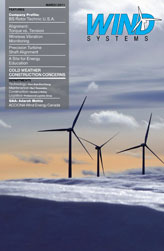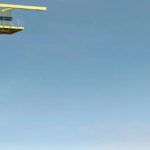Proper alignment of any bolted joint can be achieved by the use of either torque or tension methods of bolting. While both methods of securing the joint produce the same end result, the debate continues about which method delivers the most accurate and consistent bolt load value. If the proper bolt loads are not achieved during installation the integrity of the joint will be compromised, leading to misalignment and, if not checked, ultimate failure of the joint. These two methods of bolting are used in wind turbine installation and maintenance through the use of hydraulic torque wrenches and hydraulic bolt tensioners. The method used is typically determined by the turbine manufacturer and can include the use of one or both of these techniques.
Torque Techniques
To begin, look at the function of a bolt. The purpose is to hold or clamp two surfaces together. In order for the bolt to successfully achieve this function it has to be installed properly, which means applying the correct torque or tension to the bolt. The bolt can be thought of as a spring since it is stretched by either turning a nut through the use of torque, or by stretching the bolt through the use of tension. If the bolt is not stretched enough the joint will be loose and ultimately fail. If the bolt is stretched too much the bolt will be weakened and can ultimately fail. The correct amount of torque or tension applied will result in the bolt being stretched to a point where it will try to retract to its original shape and keep the proper tension on the joint. Figure 1
Hydraulic torque wrenches have been commonly used in the wind industry for many years in applications where torque requirements exceed the limits or safe use of manual torque tools. The basic principal of a hydraulic torque wrench is that the torque output is determined by the amount of hydraulic pressure that is applied to the tool. The unit of measure for torque is usually expressed in ft/lbs or Nm. The higher the pressure applied, the higher the torque output of the wrench.
Most hydraulic wrenches operate at pressures up to 10,000 psi. These wrenches come in two basic designs and multiple sizes. The square drive design employs the use of a socket attached to the wrench, and the low profile design is used where there are limited clearances that do not allow the use of a square drive tool. The square drive tool allows for economical flexibility for different size nuts by employing the use of standard impact sockets that are readily available. Low profile tools consist of a drive cylinder and an interchangeable link or cassette that is designed for a specific size nut. Proper tool selection must include torque requirements, bolt and nut sizes, clearances available, and proper reaction points for safe and accurate operation. Figure 2
Another factor that is critical for proper torque is following the guidelines for fastener lubrication. Some tests have shown that as much as 90 percent of torque when tightening a bolt is used to overcome friction. Following the manufacturer lubrication guidelines therefore becomes very critical to ensure proper tension or stretching of the bolt. For example, a 1” bolt is selected for a joint. The tension or bolt load required is determined to be 28,300 pounds of force to properly secure the joint. In order to achieve this, the torque that needs to be applied to the nut is 620 ft/lbs and is to be installed with no lubrication. If a moly-based lubricant was applied to the threads, the required torque to achieve the same tension or bolt load value would be only 219 ft/lbs. It is easy to see that if the guidelines are not followed, a moly-based lubricant is applied, and the torque value for a dry assembly is used, the bolt will be over-tensioned and will result in either immediate or future failure of the bolt.
Tension Tips
Hydraulic bolt tensioners have also been used in the wind industry for many years, in limited applications. They are becoming more common, and more bolting applications for wind turbine construction and maintenance now require the use of hydraulic bolt tensioners. The basic operation is the same as the hydraulic torque wrenches in that the more pressure applied to the tensioner, the more tension or bolt load is achieved. The unit of measure used for bolt load or tension is usually expressed in either pounds of force or Kn. Tensioner operating pressures can range from 10,000 to 22,000 psi, and in some cases even higher. The basic parts of a tensioner consist of a socket to tighten the nut once tension is achieved, a bridge that the load cell or cylinder rests on, and a puller bar that attaches to the stud.
Not unlike a torque wrench application, before a tensioner can be selected there are several measurements and specifications that need to be compiled—more measurements than required for a hydraulic torque wrench. These measurements typically are more critical for proper fit and tool selection. Some companies supply a worksheet that will assist in gathering the required information. With the exception of some wind turbine foundation tensioners that are designed to fit the two most commonly used foundation bolt sizes, most tensioners are size specific so the stud size and nut size, as well as height and washer thickness and diameter, are needed. The bolt grade and bolt load required should also be recorded. Measurement of the stud protrusion from the flange as well as the protrusion above the nut and washer are also needed. The protrusion measurements are important to ensure that the tensioner will rest on the flange once it is threaded on the stud and thread engagement in the tensioner is at a minimum equal to the diameter of the stud. If the tensioner does not rest on the flange the tensioner will react off of the nut once hydraulic pressure is applied and can lock itself onto the stud. If there is not enough thread engagement the threads can be stripped off of the stud before the proper tension is reached. Figure 3
The next measurements have to do with clearances. Measurements from the stud to the tower wall or any other surfaces that are perpendicular to the flange face as well as the distance between the studs are needed to ensure that the tensioner can be attached to the stud easily and be properly aligned. Any special measurements such as recesses in castings should also be noted and recorded. When all the information is gathered it can be determined if a stock tool can be used or if a custom design needs to be produced. Figure 4
Once a tensioner has been selected the manufacturer’s tensioning procedure and specifications should be reviewed. What is the bolt load required? What is the bolting pattern? Can the joint be tensioned to 100 percent of the bolt load required, or does it have to be tensioned in stages? Should more than one tensioner be used simultaneously to tension the joint? These are some of the elements of the tensioning procedure that need to be verified. Basic operation of the tensioner consists of attaching the tensioner to the stud and connecting the tensioner to the hydraulic pump using an appropriately rated hydraulic hose.
The next step is to adjust the hydraulic pump pressure to achieve the proper output of the tensioner. Once the proper pressure has been applied to the tensioner the bolt will be stretched and the nut that is on the flange face can be tightened. Minimal torque is required to tighten this nut, as the tensioner has already stretched the stud to the appropriate tension. The pressure can now be released, and the tensioner removed. Figure 5
Training Critical
Once the method of tightening a bolt is determined, either torque or tension, it is very important to properly train the personnel who will be performing the work. This is not only important for joint integrity, but also to prevent any injuries to the operators or damage to the application. Proper tool handling and maintenance training can go a long way in preventing these occurrences, and many tool companies will provide this upon request. Inspection of the tooling should include power cords for fraying, hydraulic hoses and couplings for proper rating, and inspection for any hydraulic oil leaks or hose and coupling damage, as well as overall condition of the tools including proper lubrication and calibration. Following these guidelines and procedures will result in a properly tightened joint that will remain aligned and be less prone to failure. Figure 6








































